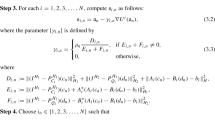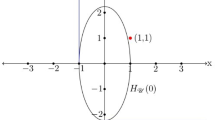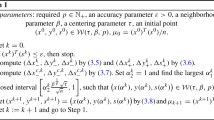Abstract
It is well known that the P3P problem could have 1, 2, 3 and at most 4 positive solutions under different configurations among its three control points and the position of the optical center. Since in any real applications, the knowledge on the exact number of possible solutions is a prerequisite for selecting the right one among all the possible solutions, and the study on the phenomenon of multiple solutions in the P3P problem has been an active topic since its very inception. In this work, we provide some new geometric interpretations on the multi-solution phenomenon in the P3P problem, and our main results include: (1) the necessary and sufficient condition for the P3P problem to have a pair of side-sharing solutions is the two optical centers of the solutions both lie on one of the three vertical planes to the base plane of control points; (2) the necessary and sufficient condition for the P3P problem to have a pair of point-sharing solutions is the two optical centers of the solutions both lie on one of the three so-called skewed danger cylinders;(3) if the P3P problem has other solutions in addition to a pair of side-sharing (point-sharing) solutions, these remaining solutions must be a point-sharing (side-sharing ) pair. In a sense, the side-sharing pair and the point-sharing pair are companion pairs; (4) there indeed exist such P3P problems that have four completely distinct solutions, i.e., the solutions sharing neither a side nor a point, closing a long guessing issue in the literature. In sum, our results provide some new insights into the nature of the multi-solution phenomenon in the P3P problem, and in addition to their academic value, they could also be used as some theoretical guidance for practitioners in real applications to avoid occurrence of multiple solutions by properly arranging the control points.











Similar content being viewed by others
References
Grunert, J.A.: Das pothenotische problem in erweiterter gestalt nebst uber seine anwendungen in der geodasie. Grunerts Archiv fur Mathematik und Physik 1, 238–248 (1841)
Fischler, M.A., Bolles, R.C.: Random sample consensus: a paradigm for model fitting with applications to image analysis and automatic cartography. Gr. Image Process. 24, 381–395 (1981)
Lowe, D.G.: Fitting Parameterized Three-Dimensional Models to Images. IEEE Trans. Pattern Anal. Mach. Intell. 13(5), 441–450 (1991)
Lepetit, V., Fua, P.: Monocular model-based 3D tracking of rigid objects: a survey. Found. Trends Comput. Gr. Vis. 1(1), 1–89 (2005)
McGlove, C., Mikhail, E., Bethel, J.: Manual of Photogrametry, 5th edn. American Society for Photogrammetry and Romote Sensing (2004)
Nister, D.: A minimal solution to the generalized 3-point pose problem. J. Math. Imaging Vis. 27(1), 67–79 (2007)
Jia, Q.X., Zheng, P., Sun, H.X.: The study of positioning with high-precision by single camera based on P3P algorithm. In: INDIN’06, IEEE International Conference on Industrial Informatics, pp. 1385–1388 (2006)
Tang, J., Chen, W., Wang, J.: A study on the p3p problem. In: ICIC’08, 4th International Conference on Intelligent Computing, vol. 5226, pp. 422–429 (2008)
Tang, J., Liu, N.: The unique solution for p3p problem, SIGAPP’09, ACM Symposium on Applied Computing, pp. 1138–1139 (2009)
Kneip, L., Scaramuzza, D., Siegwart, R.: A novel parameterization of the perspective-three-point problem for a direct computation of absolute camera position and orientation. In: IEEE International Conference on Computer Vision and Pattern Recognition, pp. 2969–2976 (2011)
Li, S., Xu, C.: A stable direct solution of perspective-three-point problem. IEEE Trans. Pattern Anal. Mach. Intell. 25(5), 627–642 (2011)
Quan, L., Lan, Z.: Linear N-point camera pose determination. IEEE Trans. Pattern Anal. Mach. Intell. 21(7), 774–780 (1999)
Haralick, R.M., Lee, C.N., Ottenberg, K., Nolle, N.: Review and analysis of solutions of the three point perspective pose estimation Problem. Int. J. Comput. Vis. 13(3), 331–356 (1994)
Faugere, J.C., Moroz, G., Rouillier, F., El-Din, M.S.: Classification of the perspective-three-point problem, discriminant variety and real solving polynomial systems of inequalities. In: ISSAC’08, 21st International Symposium Symbolic and Algebraic Computation, pp. 79–86 (2008)
Wolfe, W.J., Mathis, D., Sklair, C.W., Magee, M.: The perspective view of three points. IEEE Trans. Pattern Anal. Mach. Intell. 13(1), 66–73 (1991)
Gao, X.S., Hou, X.R., Tang, J.L., Cheng, H.F.: Complete solution classification for the perspective-three-point problem. IEEE Trans. Pattern Anal. Mach. Intell. 25(8), 930–943 (2003)
Gao, X.S., Tang, J.L.: On the probability of the number of solutions for the P4P problem. J. Math. Imag. Vis. 25(1), 79–86 (2006)
Wu, Y.H., Hu, Z.Y.: PnP problem revisited. J. Math. Imag. Vis. 24(1), 131–141 (2006)
Rieck, M.Q.: An algorithm for finding repeated solutions to the general perspective three-point pose problem. J. Math. Imag. Vis. 42, 92–100 (2012)
Rieck, M.Q.: Solving the three-point camera pose problem in the vicinity of the danger cylinder. In: VISAPP’12, International Conference Computer Vision Theory and Applications, vol. 2, pp. 335–340 (2012)
Rieck, M.Q.: A fundamentally new view of the perspective three-point pose problem. J. Math. Imag. Vis. 48, 499–516 (2014)
Rieck, M.Q.: On the discriminant of Grunert’s system of algebraic equations and related topics. J. Math. Imag. Vis. 60, 737–762 (2018)
Zhang, C.X., Hu, Z.Y.: Why is the danger cylinder dangerous in the p3p problem? Acta Autom. Sin. 32(4), 504–511 (2006)
Zhang, C.X., Hu, Z.Y.: A general sufficient condition of four positive solutions of the p3p problem. J. Comput. Sci. Technol. 20(6), 836–842 (2005)
Wolfe, W.J.: A special case solution to the perspective 3-point problem. http://faculty.csuci.edu/william.wolfe/CSUCI/articles/PerspectiveView/New_P3P_Article/Wolfe_P3P_Special_Case.pdf (2008)
Sun, F.M., Wang, B.: A note on the roots of distribution and stability of the PnP problem. Acta Autom. Sin. 36(9), 1213–1219 (2010)
Thompson, E.H.: Space resection: failure cases. Photogramm. Rec. 5(27), 201–204 (1966)
Wang, B., Zhang, C.X., Hu, Z.Y.: A P3P problem with 4 completely distinct solutions. TR-CASIA-NLPR-RV-2015-03-13
Wang, B., Hu, H., Zhang, C.X.: New insights on multi-solution distribution of the P3P problem. arXiv:1901.11464v1 (2019)
Acknowledgements
This work was partially supported by the National Natural Science Foundation of China under the Grant Nos. (61873264, 61333015, 61421004, 61403373, 61503004).
Author information
Authors and Affiliations
Corresponding author
Additional information
Publisher's Note
Springer Nature remains neutral with regard to jurisdictional claims in published maps and institutional affiliations.
Appendices
Appendix
Proof of four different P3P solutions by Macaulay 2
We use the coordinates of the three control points A, B, C and an optical center O as the original variables, and we set these parameters as rational number:
\(|AB|, |BC|, |CA|, \cos \alpha , \cos \beta \) and \(\cos \gamma \) can be expressed by the coordinates A, B, C and O as:
Then, by substituting the above |AB|, |BC|, |CA|, \(\cos \alpha \), \(\cos \beta \) and \(\cos \gamma \) into Eq. (1), with \(s_1, s_2, s_3\) as the variables. Then, an ideal is generated by the three equations in Eq. (1) over the field \({\mathbb {Q}}\)(rational number). Then, we use the function “degree” in Macaulay to get the degree of this ideal. The output degree is 8, it means that there are eight different intersecting points of the three curves in Eq. (1). Since if \((s_1, s_2, s_3)\) satisfies Eq. (1), \(-(s_1, s_2, s_3)\) also satisfies Eq. (1), and hence, it shows there exist four different P3P solutions.
Rights and permissions
About this article
Cite this article
Wang, B., Hu, H. & Zhang, C. Geometric Interpretation of the Multi-solution Phenomenon in the P3P Problem. J Math Imaging Vis 62, 1214–1226 (2020). https://doi.org/10.1007/s10851-020-00982-5
Received:
Accepted:
Published:
Issue Date:
DOI: https://doi.org/10.1007/s10851-020-00982-5




